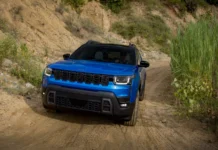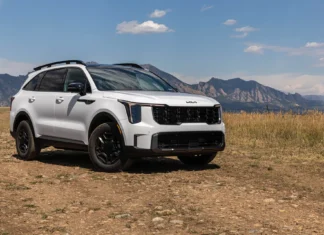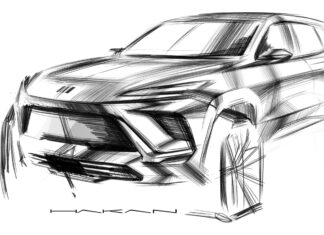
If you’re rear-ended in a Tesla, this is what it may cost to repair the damage.
Earlier this month, we covered how much the cost to fix our long-term Tesla Model 3 has ballooned so far. Right now, our local Tesla-approved collision repair center has estimated our costs at over $10,000. However, that’s nothing compared to Josh, who shared his own repair story after we published our video.
This is how his message started: “I thought I’d like to share my repair story with you. Maybe enough stories will influence change…”
Josh pre-ordered his Tesla Model 3 the day the car was announced. At the time, his Performance Model came out to $79,000 including options. That included the following:
- $1,000 for Obsidian Black Metallic Paint
- $5,000 for Enhanced Autopilot
- $3,000 for Full Self-Driving Capability
- $5,000 for Performance Upgrade Package

He had driven his car for 8 months and 9,000 miles when he ended up in an accident on May 8, 2019. Onboard footage Josh provided below shows a third-generation Lincoln Navigator smashing into his Tesla. Fortunately, the car rockets away at the last moment, mitigating some of the impact. It could have been much worse.
Assessing the damage
The day after his collision, Josh went to a local insurance adjuster, and was “told they can’t give estimates on Tesla,” according to his e-mail. Later, the insurance company demanded his car was towed to a certified repair shop 1-1/2 hours away. That is not too unfamiliar to our own experience, where the nearest repair shop is an hour away from our office.
On May 10, the insurance company went to the body shop. From there, Josh received his first estimate for the damage: $9,540.79.
The body shop warned him that insurance does not like to pay for renting the “Celette fixture”, a universal jig system used to assess and properly repair structural damage. The body shop doesn’t own one “because the market in this area is small,” they told Josh.
They also mentioned their concern that the battery may be damaged. However, the insurance company did not approve a pre-scan prior to tearing down the car. The body shop did a tear down, then had to reassemble the car for an electronic component test. “If the battery is damaged, the car may break its threshold for total loss,” Josh told us in his e-mail.
More estimates, diagnosis
On May 14, the local body shop submitted a supplemental estimate to the insurance company’s original total. That brings the running repair cost up to $21,956.33 — more than double the first estimate. The insurance company agreed to pay out $7,437.47 more (bringing their covered cost to $16,978.26). On May 24, “after threatening them with an attorney”, the insurance company agreed to rent the Celette fixture to the tune of $1,200.
Fortunately, the electronic component test came back clean on May 29, showing no signs of battery damage. On June 4, the insurance representative spent four hours at the body shop, and developed this work plan for fixing Josh’s Tesla:
- Order Celette fixture
- Complete dismantling, diagnosis
- Request insurance out (for the 6th time) to inspect any uncovered damage
- Clear supplemental estimates
- Send Celette fixture back to vendor
- Order all identified parts (and wait for parts to arrive)
- Re-order the Celette fixture once the parts arrive
- Repair the Tesla
The body shop ordered the Celette fixture on June 5. Nearly a week later, on June 11, the fixture arrived and the insurance company sent over $2,269.00 more to cover the rental.
The costs (so far)
On June 13 — the latest update Josh hears the frame rails have shifted on his Tesla Model 3. The left frame rail moved up 8 millimeters and to the left by 6 millimeters. The right frame rail shifted up 7 millimeters.
Then the story takes an unexpected turn. The insurance company also informs Josh that the at-fault driver — in the Lincoln Navigator in the video, remember — said he hit a “white Explorer”, not a black Tesla. “The day of the accident, my local police department was not responding to non-emergency calls, so I do not have a police report, but I do have video and a ton of pictures. What was this guy thinking?”
Then, to make things worse, Josh received information on another supplemental to fix the frame rails. Now, the total is up to $35,638, including 167.6 total hours of labor. According to Josh, the total loss threshold for his Tesla, minus its depreciation, is $45,000. So, if repairs get any more expensive, the insurance company may just end up writing the car off.
The bottlenecks
Mirroring our own repair experience, Josh describes what he’s found looking into other owners’ stories. “Typically, I’ve been reading there are 3 different bottlenecks”:
- Waiting for the shop to be able to inspect the car (Some shops in California reportedly have queues “over 100” of Teslas awaiting inspection
- Waiting for parts to arrive from Tesla (the company sources its parts in-house)
- Negotiating with insurance
That’s the situation for Josh as it currently stands. Right now, he is six weeks out from his initial accident, with no definitive date on when his car will be repaired. Our own TFL long-term Tesla Model 3 is in a similar situation.
![The Tesla Model 3 Is 'Needlessly' Complicated to Assemble, According to Analysts [News]](https://tflstudios.wpengine.com/wp-content/uploads/2018/10/tesla-model-3-overview-e1539884410343-1024x547.jpg)
What this means for you
The reason we’ve shared our repair experience and those of owners like Josh with you is the fact that you may want to consider accidents when you’re weighing up whether to buy a Tesla. Presently, repair queues are long and fixing even minor collisions may be expensive. Unlike other more traditional cars, a long wait means you may be without your car for a long period of time.
That’s a problem, since many people are swapping for a Tesla as their primary vehicle. Most of us can’t live without our cars for months at a time. Even if the insurance companies fork out money for a rental, most will hesitate to keep paying for it past a certain point. That means you may end up shelling out some of your own money for transportation because the repairs are taking so long.
Tesla does rely on its own approved body repair shops, and the company sources its own parts. Most manufacturers have external parts suppliers, and allow third-party body shops to repair their cars. That makes the process much faster and less expensive. Perhaps that could change if Tesla opened up its repair process. The company may have to consider that option, since so many more cars are now on the roads, and stories like that Josh’s Model 3 will become more common.
























